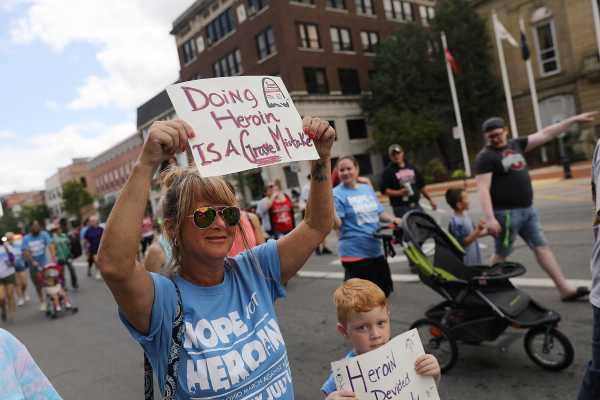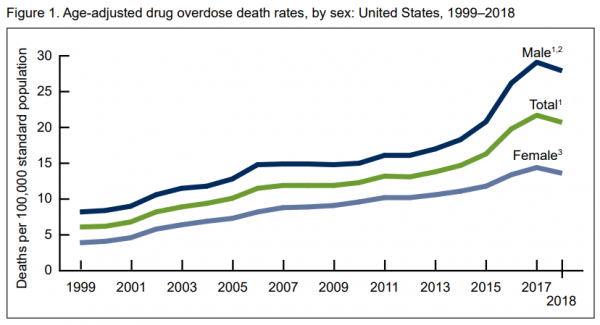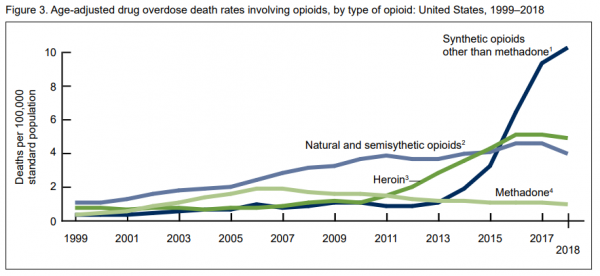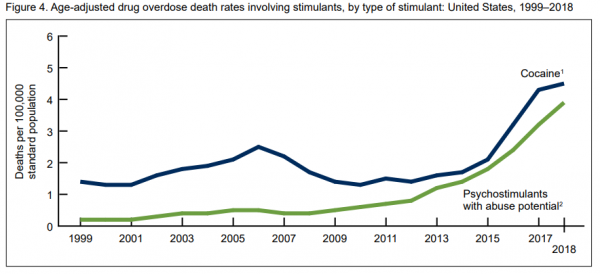
American drug overdose deaths fell for the first time in 28 years in 2018 but remain near record highs, according to a new report released by the Centers for Disease Control and Prevention on Thursday.
The report put total drug overdose deaths at more than 67,000 in 2018, down 4 percent from over 70,000 in 2017. That adds up 20.7 drug overdose deaths per 100,000 people in 2018, compared to 21.7 in 2017. It’s the first recorded fall in overdose deaths since America’s opioid epidemic began in the 1990s.
But that still makes 2018 the second-worst year for drug overdose deaths in US history. The rate of drug overdose deaths is still more than three times what it was in 1999, and overdose deaths are still higher than deaths due to gun violence, car crashes, or HIV/AIDS at its peak.

Life expectancy at birth among Americans also increased slightly — by 0.1 years, from 78.6 years in 2016 to 78.7 years in 2018. That was partially attributable to the dip in drug overdose deaths. But that’s still below the peak of 78.9 years in 2014, the CDC noted.
The overdose death rate was highest in West Virginia (51.5 per 100,000), Delaware (43.8), Maryland (37.2), Pennsylvania (36.1), Ohio (35.9), and New Hampshire (35.8). Overdose deaths fell in 14 states in 2018, including Ohio, Pennsylvania, and West Virginia. They increased in five: California, Delaware, Missouri, New Jersey, and South Carolina.

The Rehab Racket is Vox’s investigation into America’s notoriously opaque addiction treatment industry. We’re crowdsourcing patients’ and families’ rehab stories, with an emphasis on the cost of treatment and quality of care. If you’d like to help our reporting by sharing your story, please fill out this survey.
The opioid epidemic began in the 1990s, as the proliferation of opioid painkillers — not just for patients but among teens rummaging through their parents’ medicine cabinets, friends and family, and the black market — led to a spike in opioid addiction and overdoses. That first wave was followed by two others as drug cartels capitalized on the rise of addiction, through first the rise of cheap, potent heroin and then the spread of even cheaper and more potent fentanyl. With each of the three waves of the opioid epidemic, addiction cases and overdose deaths increased.
The CDC numbers suggest that, for the first time in three decades, the opioid crisis may be getting better. But overdose deaths remain historically high — and there are red flags in the data that should invite caution before anyone declares victory over the opioid epidemic.
It’s too early to celebrate the end of the opioid epidemic
The good news in drug overdose deaths was buoyed largely by a drop in overdose deaths linked to opioid painkillers — perhaps a result of government and other efforts to cut back on opioid prescriptions (though the US still generally prescribes far more opioids than the rest of the world).
Still, there were significant increases in some kinds of drug overdoses, particularly those involving illicit synthetic opioids like fentanyl, cocaine, and stimulants like meth. The age-adjusted overdose death rate for synthetic opioids excluding methadone increased by 10 percent from 2017 to 2018. The rate for cocaine increased by nearly 5 percent, while the rate for stimulants like meth increased by nearly 22 percent — though stimulant overdose deaths in general were still dwarfed by opioid overdose deaths.

This is where advocates and experts call for caution in regards to the new numbers: It’s entirely possible that as opioid painkiller deaths plateau or fall, other drug overdose deaths will rise and overcome any gains. That wouldn’t be unprecedented: Drug overdose deaths appeared to plateau around 2012 before reaching new record highs in the ensuing years.
A recent report by the RAND Corporation, for one, warned that fentanyl could expand to parts of the US where it hasn’t reached illicit drug markets yet — potentially leading to a spike in overdose deaths in areas accustomed to less potent and relatively less dangerous heroin.
Separately, experts have warned about a possible stimulant epidemic. As Stanford drug policy expert Keith Humphreys previously told me, “Every opioid epidemic in American history has been followed by a stimulant epidemic.”

Part of this reflects the lopsided efforts that the US has taken in response to the opioid crisis. Government and public health officials have taken several steps to cut back on the overprescription of opioids, with some success in recent years.
At the same time, the US hasn’t done anywhere near enough to build up its addiction treatment infrastructure — either in terms of investing the tens of billions of dollars experts argue is necessary or by ensuring the treatment system is using evidence-based practices. Despite President Donald Trump’s campaign promises to “spend the money” necessary to fight the opioid epidemic, he hasn’t delivered.
The US also hasn’t done enough to embrace harm reduction practices that can save lives. Although the opioid overdose antidote naloxone has proliferated in the past decade, the country still lags the developed world in needle exchanges, supervised consumption sites, and prescription heroin.
And the country still seems to struggle with underlying conditions that experts say are fueling “deaths of despair.” That’s not just drug overdoses but also suicides, which increased in 2018, and alcohol-related deaths, which have doubled in the past two decades. Research by Princeton economists Anne Case and Angus Deaton has pinned these deaths of despair on various issues, including the collapse of economic opportunities in much of the country, a growing sense of social isolation, and untreated mental health issues.
“If all of these social factors were there, and we didn’t have the supply of drugs, of course people would not be dying of overdoses,” Nora Volkow, director of the National Institute on Drug Abuse, previously told me. “But it is the confluence of the widespread markets of drugs — that are very accessible and very potent — and the social-cultural factors that are making people despair and seek out these drugs as a way of escaping.”
All of that leaves America vulnerable to increases in drug addiction cases and overdose deaths, even as it sees some gains due to drops in opioid prescriptions and related deaths.
But, at least in 2018, the US saw a rare drop in drug overdose deaths.
Sourse: vox.com






